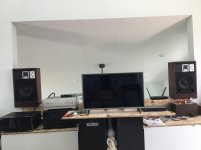Yes, similarly having them out in the room creates more depthYou know what’s really cool is a flat screen between the speakers....the phantom center affect is crazy! It takes a little jockeying to get it right though.
Are you thinking more now about shift due to speaker jitter? That may have an audible amount
No, just a way to determine ITD capability. By in the wild, I mean without headphones.
If I were determining thresholds, I would have them judge the test signal's position in reference to an actual source located at the center, a real speaker.
Jn
A hearing threshold is usually defined at the 50% correct response level and an adaptive procedure is used, starting at higher levels of the independent variable and lowering it in dependence of the correctness of the response (up-and-down procedures), so the 50% p(c) level is likely marking the threshold where the responses are randomly given.
This figure showed the responses of the trained listeners and if they were guessing at the lower ITD´s one would expect to have some distribution of corrects responses around the 50% level.
If, as in this case, all listener´s responses were above that level, it is quite unlikely that they were just guessing.
Iow, under the assumption that the hypothesis of random guessing at 2,x us ITD is true, the occurence of the observed data is quite incompatible to the random guessing hypothesis.
So what you are saying is that tests that fell below the 50% correct threshold are basically taken as the threshold. Ok - makes sense to me - thanks
With point sources, yes, but what about a phantom centre?Comb filtering is an interesting phenomenon. Our ears/head have comb filters and our brains can easily work it out.
No, just a way to determine ITD capability. By in the wild, I mean without headphones.
If I were determining thresholds, I would have them judge the test signal's position in reference to an actual source located at the center, a real speaker.
Jn
Ahhh.....sorry, some terminology still eludes me! lol
Ahhh.....sorry, some terminology still eludes me! lol
Interaural time difference - Wikipedia He used "in the wild" differently earlier in the discussion IIRC, to mean.....errr....in the wild
Last edited:
Been there, did that. My discussion is informed by experience.Jn, why don't you try?
Jn
Yes, similarly having them out in the room creates more depth
You wanna talk depth? ....look at this screwy positioning, it’s got the real amphitheater depth!
Just a temporary thing till I get my cabinetry done for the entertainment center.
Attachments
Except for insulting everybody’s intelligence and basic common sense. Happens that “close minded” rely on intelligence and common sense.
Seems to be a different definition of the terms "close-minded" and "open-minded" .........
Been there, did that. My discussion is informed by experience.
Jn
Would you share your data, results? As you know, I don't care much about debates.
So what you are saying is that tests that fell below the 50% correct threshold are basically taken as the threshold. Ok - makes sense to me - thanks
No, that is a misunderstanding. The threshold is usually defined as the point where 50% of the responses (to the experimental task) are correct.
A series of tests is considered to be a probabilistic experiment; humans aren´t machines, variables aren´t constant over time and so on.
So a series of tests will give results distributed around the real (assumed to be fixed but unknow) value of the 50% of correct responses level. The average is a good estimator (converging to the real value) for the mean.
I´ll try to come back with some further explanations tomorrow or the day after.
Again, been there did that. The problem is, some others with a bee up their bonnett will perform the tests badly using poor test methodology without understanding so as to try and prove themselves right. Pretty much what you did.Would you share your data, results? As you know, I don't care much about debates.
I have no desire to spoon feed you, as you won't learn that way.
Most important here is critical thinking skills.
Edit: and that is not meant as an insult, most people when forced out of their comfort zone w/r to knowledge, tent to stumble a bit.
Jn
Last edited:
It seems most here aren't aware of that? So, as someone said earlier, what's really going on here?Again, been there did that.
Interaural time difference - Wikipedia He used "in the wild" differently earlier in the discussion IIRC, to mean.....errr....in the wild
That’s kinda what I thought but trying not to scrutinize !
I guess any software they used would have to delay via the digital samples? I wonder if they verified that what they requesting of the unit actually happened as they expected?
jn
You can do sub-sample shift via FIR. http://home.agh.edu.pl/~turcza/sr/Splitting the Unit Delay.pdf
The entire audio chain is comprised of some very complicated stuff. Electronics which many here are excellent at, speakers...same deal, sources, testing, etc.It seems most here aren't aware of that? So, as someone said earlier, what's really going on here?
But there is a disconnect. A virtual soundstage requires more than just low distortion electronics. It is important to understand what compromises the virtual image.
Without understanding what is needed how does one control it?
Over the years I've tested the stability of both lateralization as well as localization on myself only. And in that process I've had to do a lot of research.
We have quite a few here that are very knowledgeable in human hearing capabilities, it is important that all discuss.
Jn
- Status
- Not open for further replies.
- Home
- Member Areas
- The Lounge
- John Curl's Blowtorch preamplifier part III
